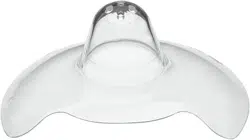
Nipple Shield
Medela nipple shields can be an effective
tool for a new breastfeeding mother with
latch-on problems or an overactive let-down
response. The nipple shields enable continued
breastfeeding without interruption until these
problems are resolved.
When to Use
Flat or inverted nipples: Some babies
have difficulty latching onto the breast.
Flat or inverted nipples can contribute to
latch-on problems. A nipple shield gives
the baby a larger area to latch onto, while
breastfeeding helps draw the nipple
out. This makes it easier for the baby to
subsequently latch onto the breast without
the nipple shield.
Latch-on difficulties: Other babies are
slow to learn how to latch on in the first
week. The use of a nipple shield can
temporarily assist the baby in attachment
to the breast, until the baby has learned
the proper technique without the use of a
shield. Silicone has been used by Medela
in the manufacturing of their Nipple Shield
because it has minimal odor and taste.
Overactive let-down: Occasionally a
mother will have an overactive let-down
response which can cause a baby to
choke and pull off the breast. Using a
nipple shield can slow down the flow of
milk, thus enabling the baby to continue
nursing. As the baby matures and becomes
more coordinated with the sucking and
swallowing, the nipple shield is no longer
needed.
WARNING: It is important to use a nipple
shield under the direction of a healthcare
professional or lactation consultant.
How to Use
Always wash the nipple shield in hot soapy
water and rinse in hot water before and
after use.
Place the nipple shield in hot water prior
to nursing. This makes the shield more
pliable and adhere to the breast better.
A small amount of lanolin cream under the
rim, but not in the nipple portion, may also
help it adhere to the breast.
Handle the nipple shield by the rim. Turn
the nipple shield inside-out halfway. Place
the nipple shield over the breast with the
nipple centered inside the nipple portion
of the shield. Then flip the shield right
side out, enclosing as much of the nipple
as possible. If using the Contact
™
nipple
shield, position the open section where the
baby’s nose will contact the breast.
Support the breast with a “C” hold. Place
thumb on top of the breast and nipple
shield and with fingers below, away
from the areola (the dark pigmented skin
surrounding the nipple).
Tickle baby’s lower lip with nipple until he
opens WIDE, then quickly pull baby onto
the nipple shield, so baby takes as much
of the nipple as possible into his mouth.
If the nipple shield is being used for a baby
having difficulty latching onto the breast,
remove the nipple shield after a minute or
two of breastfeeding. Try to attach the baby
to the breast without the nipple shield.
Continue to do this with each feeding
until the baby is able to latch-on without
the shield. Some babies need only one or
two sessions with the nipple shields, while
others may need more.
Cleaning & Care
Follow these instructions unless otherwise
instructed by your healthcare provider.
Sanitize nipple shields by thoroughly boiling
in water for 20 minutes. (Some healthcare
providers recommend washing nipple
shields in hot soapy water. Check with
your healthcare provider for instructions
on cleaning).
Store with the nipple facing upwards and
keep in a clean and dry covered container.
For further help with breastfeeding, contact a
healthcare professional or lactation consultant.
For the names of a breastfeeding specialist
in your area, you can call the Breastfeeding
National Network (BNN) at 1-800-TELL YOU
(in the US and Canada) or online at
www.medela.com.
Español
La copa Medela para pezones es la
herramienta ideal para una madre nueva
que amamanta y tiene problemas con el
sujetamiento o una respuesta sobreactiva
del flujo. La copa para pezones ayuda al
amamantamiento continuo sin interrupción
hasta que estos problemas sean resueltos.
Cuando Usarla
Pezones planos o invertidos: Algunos
bebés tienen dificultades en adherirse
al seno. Los pezones planos o invertidos
pueden contribuir a los problemas de
adherimiento. Una copa para pezones le da
al bebé un área más grande para adherirse,
mientras el amamantamiento ayuda a
sacar al pezón. Esto lo hace más fácil para
el bebé adherirse subsecuentemente al
seno sin la copa para pezones.
Dificultades de adherimiento: Otros
bebés son lentos en aprender como
adherirse durante la primera semana. El
uso de la copa para pezones puede asistir
temporalmente al bebé a adherirse al
seno, hasta que el bebé haya aprendido
la técnica propia sin el uso de la copa.
El silicón ha sido usado por Medela en la
manufactura de sus copas para Pezones
porque tiene un olor y sabor mínimo.
Flujo sobre-activo: Ocasionalmente una
madre tendrá una respuesta sobre-activa del
flujo que puede causar que el bebé suelte
el seno ahogándose. Usar una copa para
pezones puede alentar el flujo de la leche, así
ayudando al bebé a continuar amamantando.
Conforme el bebé madure y se haga más
coordinado con la succión y el tragar, la copa
para pezones ya no será necesitada.
ADVERTENCIA: Es importante usar la copa
para pezones bajo la dirección de un
profesional en el cuidado de la salud o de un
consultor en lactancia.
Manufactured for
Medela, Inc., 1101 Corporate Drive, P.O. Box 660, McHenry IL 60051-0660, USA
Phone (800) 435-8316 Fax (815) 363-1246 Email: customer[email protected]
www.medela.com
Medela Canada, Inc., 4160 Sladeview Crescent, #8, Mississauga, Ontario, Canada, L5L 0A1
Tel/Tél: 800.435.8316, Fax/Téléc: 800.995.7867, [email protected]
Medela is a registered trademark of Medela. Contact is a trademark of Medela.
Medela es una marca registrada de Medela en los EE.UU. y en otros paises.
Medela est une marque déposée de Medela aux Ètats-Unis et dans d’autres pays.
1907634 B 0410 © 2010 Medela, Inc.
Nipple Shield
Instructions for use
Instrucciones de uso
Mode d’emploi
Loading ...
